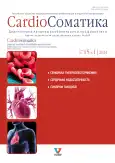Spontaneous coronary artery dissection in a young woman with signs of connective tissue dysplasia and hereditary thrombophilia: clinical case
- Authors: Feoktistova V.S.1, Boldueva S.A.1, Burak T.Y.1, Kretova V.E.1
-
Affiliations:
- Mechnikov North-Western State Medical University
- Issue: Vol 15, No 1 (2024)
- Pages: 81-90
- Section: Case reports
- URL: https://journals.rcsi.science/2221-7185/article/view/256942
- DOI: https://doi.org/10.17816/CS622871
- ID: 256942
Cite item
Full Text
Abstract
BACKGROUND: Spontaneous coronary artery dissection (SCAD) is a disease that develops unrelated to intracoronary intervention, atherosclerosis, aortic dissection, or mechanical trauma and causes a false lumen (intramural hematoma) in the wall of the coronary artery (CA) with impaired blood flow in it and myocardial ischemia in the affected region of the CA. SCAD most often develops in young and middle-aged adults (aged ≤50 years); among women, it becomes the culprit in 24%–35% of cases of acute myocardial infarction (MI). SCAD is a risk factor for MI, and incorrect interpretation of the angiographic picture and intravascular imaging methods can lead to incorrect tactics of patient behavior.
CLINICAL CASE DESCRIPTION: This article presents a clinical case of SCAD leading to the development of MI in a young woman with concomitant connective tissue dysplasia and hereditary thrombophilia. The angiographic disease course resembled focal atherosclerosis, and in the course of invasive management, complications had arisen, confirming the probable genesis of coronary artery obstruction.
CONCLUSION: SCAD is a complex disease, with a sudden onset and an ambiguous prognosis. In most cases, SCAD develops in young women in the absence of cardiovascular factors. It is difficult to diagnose because its signs and symptoms are similar to more common diseases, mainly MI. SCAD can masquerade as focal stenosis on an angiogram, mimicking an atherosclerotic plaque. The «gold standard» for diagnosing SCAD is optical coherence tomography (OCT). OCT enables the visualization of the state of all coronary artery walls and elucidates the pathogenetic mechanisms of MI. If performing OCT is impossible after diagnostic coronary angiography in young patients in suspected cases, the likelihood of DST and SCAD risk must be assessed to avoid errors in choosing treatments. The technical accessibility of intracoronary imaging methods reduces the frequency of diagnostic and, consequently, treatment errors.
Full Text
##article.viewOnOriginalSite##About the authors
Valeria S. Feoktistova
Mechnikov North-Western State Medical University
Email: lerissima@yandex.ru
ORCID iD: 0000-0003-4161-3535
MD, Cand. Sci. (Med.), associate professor
Russian Federation, St. PetersburgSvetlana A. Boldueva
Mechnikov North-Western State Medical University
Email: svetlanaboldueva@mail.ru
ORCID iD: 0000-0002-1898-084X
MD, Dr. Sci. (Med.), department professor
Russian Federation, St. PetersburgTaras Y. Burak
Mechnikov North-Western State Medical University
Email: burak_t@mail.ru
ORCID iD: 0000-0003-2591-2738
Scopus Author ID: 929468
MD, Cand. Sci. (Med.), associate professor
Russian Federation, St. PetersburgVeronika E. Kretova
Mechnikov North-Western State Medical University
Author for correspondence.
Email: miss.kretova2018@yandex.ru
ORCID iD: 0009-0007-8124-3838
student
Russian Federation, St. PetersburgReferences
- Adlam D, Alfonso F, Maas A, et al. European Society of Cardiology, Acute Cardiovascular Care Association, SCAD study group: a position paper on spontaneous coronary artery dissection. Eur Heart J. 2018;39(36):3353–3368. doi: 10.1093/eurheartj/ehy080
- Hayes SN, Kim ESH, Saw J, et al. Spontaneous Coronary Artery Dissection: Current State of the Science: A Scientific Statement From the American Heart Association. Circulation. 2018;137(19):e523–e557. doi: 10.1161/CIR.0000000000000564
- Saw J, Mancini GBJ, Humphries KH. Contemporary Review on Spontaneous Coronary Artery Dissection. J Am Coll Cardiol. 2016;68(3):297–312. doi: 10.1016/j.jacc.2016.05.034. Erratum in: J Am Coll Cardiol. 2016;68(14):1606.
- Garcia-Guimarães M, Bastante T, Antuña P, et al. Spontaneous Coronary Artery Dissection: Mechanisms, Diagnosis and Management. Eur Cardiol. 2020;(15):1–8. doi: 10.15420/ecr.2019.01
- Zhukova NS, Shakhnovich RM, Merkulova IN, et al. Spontaneous Coronary Artery Dissection. Kardiologiia. 2019;59(9):52–63. (In Russ). doi: 10.18087/cardio.2019.9.10269
- Tamis-Holland JE, Jneid H, Reynolds HR, et al. Contemporary Diagnosis and Management of Patients With Myocardial Infarction in the Absence of Obstructive Coronary Artery Disease: A Scientific Statement From the American Heart Association. Circulation. 2019;139(18):e891–e908. doi: 10.1161/CIR.0000000000000670
- Saw J, Aymong E, Sedlak T, et al. Spontaneous coronary artery dissection: association with predisposing arteriopathies and precipitating stressors and cardiovascular outcomes. Circ Cardiovasc Interv. 2014;7(5):645–655. doi: 10.1161/CIRCINTERVENTIONS.114.001760
- Cano-Castellote M, Afanador-Restrepo DF, González-Santamaría J, et al. Pathophysiology, Diagnosis and Treatment of Spontaneous Coronary Artery Dissection in Peripartum Women. J Clin Med. 2022;11(22):6657. doi: 10.3390/jcm11226657
- Martynov AI, Nechaeva GI, Akatova EV, et al. Guidelines of the Russian scientific medical society of internal medicine on the diagnosis, treatment and rehabilitation of patients with the connective tissue dysplasia (first edition). Medical News of North Caucasus. 2018;13(1–2):137–209. (In Russ). doi: 10.14300/mnnc.2018.13037
- Saw J, Humphries K, Aymong E, et al. Spontaneous Coronary Artery Dissection: Clinical Outcomes and Risk of Recurrence. J Am Coll Cardiol. 2017;70(9):1148–1158. doi: 10.1016/j.jacc.2017.06.053
- Yagoda AV, Airapetian LA. Polymorphisms of thrombophilia genes with some visceral signs of connective tissue dysplasia. Therapy. 2020;6(40):46–51. (In Russ). doi: 10.18565/therapy.2020.6.46-51
- Yagoda AV, Airapetian LA. Thrombophilia genes in external signs of connective tissue dysplasia and minor development abnormality. Medical News of North Caucasus. 2021;16(1):21–27. (In Russ). doi: 10.14300/mnnc.2021.16006
- Yagoda AV, Airapetian LA. Genetic aspects of hemostasis disorders in patients with minor heart anomalies. Medical News of North Caucasus. 2020;15(1):46–52. (In Russ). doi: 10.14300/mnnc.2020.15010
- Petrou E, Bousoula E, Boutsikou M, et al. Multivessel spontaneous dissection of the left coronary tree in the postpartum period: case report and review of the literature. Eur Rev Med Pharmacol Sci. 2014;18(24):3743–3746.
Supplementary files














